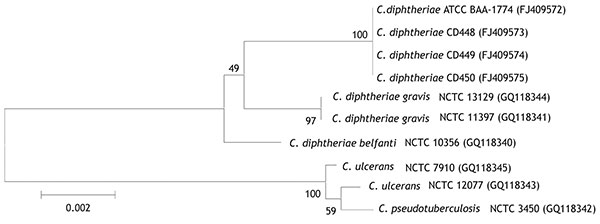Volume 16, Number 4—April 2010
Dispatch
Novel Corynebacterium diphtheriae in Domestic Cats
Figure 2

Figure 2. Jukes-Cantor–derived phylogenetic tree based on sequence analysis of a selected region of the rpoB gene of Corynebacterium isolates, including 2 feline isolates from West Virginia, 2008 (ATCC BAA-1774, CD 450). Feline isolates had 100% identity with each other and 97.7% identity with C. diphtheriae biotypes gravis and belfanti. GenBank accession nos. given in parentheses. ATCC, American Type Culture Collection; CD, Centers for Disease Control and Prevention identifier number; NCTC, National Collection of Type Cultures. Scale bar indicates number of substitutions per site.
Page created: December 28, 2010
Page updated: December 28, 2010
Page reviewed: December 28, 2010
The conclusions, findings, and opinions expressed by authors contributing to this journal do not necessarily reflect the official position of the U.S. Department of Health and Human Services, the Public Health Service, the Centers for Disease Control and Prevention, or the authors' affiliated institutions. Use of trade names is for identification only and does not imply endorsement by any of the groups named above.